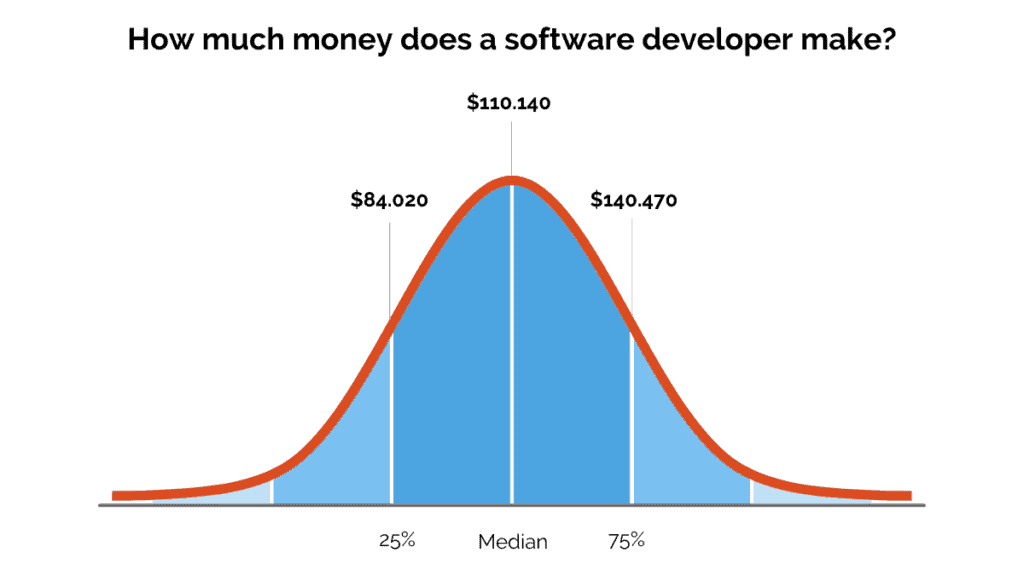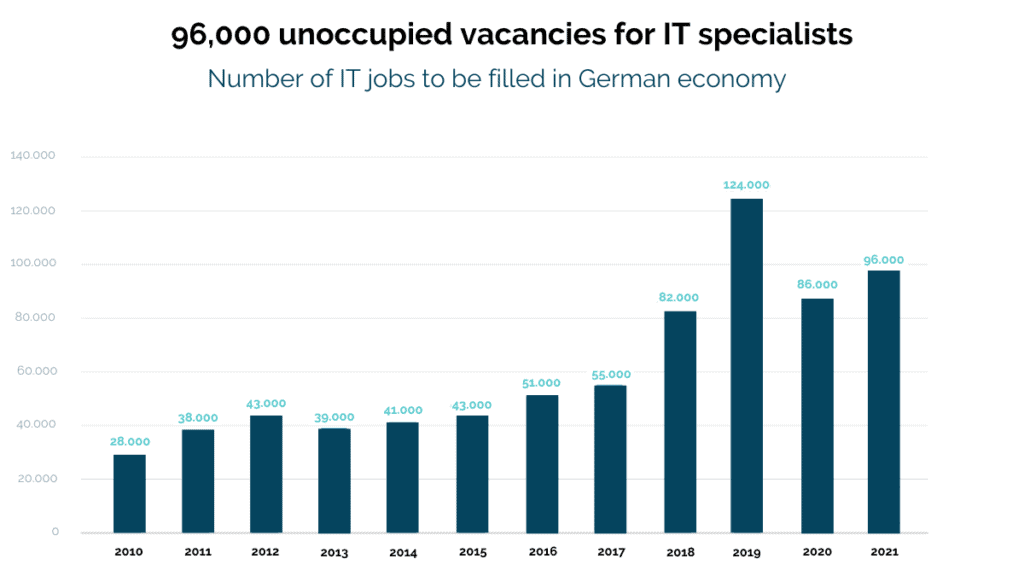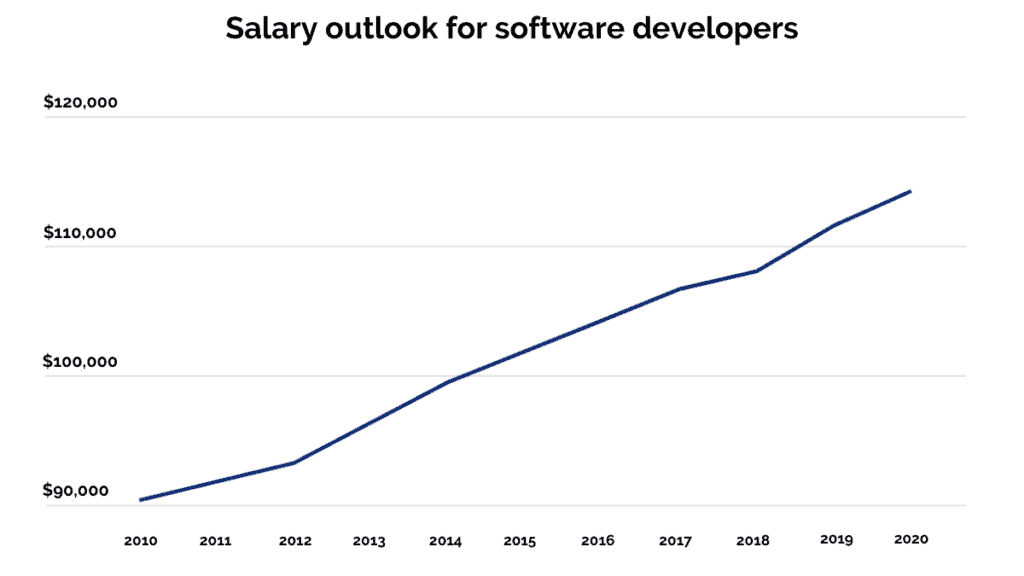If you’re thinking about a career change, you might want to consider becoming a software developer. It’s been a booming section of the employment market for years, and, far from leveling out, the competition to hire developers and engineers is increasing.
In the USA, for example, the median salary for software developers was over $110,000 by 2020. By 2026, there is predicted to be a shortfall of over one million deveblopers in that nation alone.
Salary growth, job security, and abundant new opportunities; who could ask for more? But this situation, while seemingly beneficial for developers, is certainly bad news for businesses. The developer shortage is halting innovation according to over half of CIOs who report that it’s challenging for their companies to keep up with the latest technologies.
On closer inspection, it’s also apparent that the highly skilled community of developers are facing ever tougher working environments. Regardless of the monetary rewards, developers “burn out” at an alarming rate; close to 40% cite “increasing workload and demand from other teams” as the cause. Perhaps this isn’t such a compelling career option after all?
In a nutshell, developers are well-compensated but overworked; businesses gain substantially from development capabilities but can’t hire effectively; innovation is vital but often tantalizingly out of reach. Where does that leave us?
In this article:
- Software developers: a supply and demand problem
- What is No-Code development?
- What do No-Code tools offer in practice?
- Which No-Code use cases are already powering CX?
- Are cost savings the real power of No-Code?
Software developers: a supply and demand problem
There are always two solutions to a supply and demand imbalance. One is to increase supply; let’s simply train more developers. This is underway of course, at both individual businesses and the national level.
But the reality is that these efforts will not plug the gap. In fact, they won’t come close. In Germany, in the last ten years, the number of unfilled IT roles has never been lower than 39,000.
Between 2020 and 2021, the number grew by 10,000 to a total of 96,000. If you know where 96,000 new IT specialists can be found, please let us know!
The second option is to decrease demand, and that’s the solution we’re going to explore today. But what does it mean to reduce the demand for software developers? Surely that need is chained irretrievably to the general need for innovation?
In the modern environment, even businesses that don’t have technology-oriented products feel the pull of that drive to innovate. A company selling paper umbrellas for cocktails might still discover that their success depends on the output of the developers who actually configure the services the company plans to offer.
But this is also where you will find the highest potential to reduce demand; this is where No-Code development enters the equation.
What is No-Code development?
Think about this. If you were building a house 100 years ago, you would need a skilled carpenter – or several – to create the timber frame of your roof. Every joist, purlin and rafter would be crafted and installed by carpenters.
If you built a house today, it would be a different story. The sections of your timber frame roof, constructed off-site, could be assembled in any formation by any person with a small amount of training.
Does that put the carpenters out of a job? Not at all. In fact, they’re in a better position than ever because they can focus on the genuinely skilled work that only a master craftsperson can do.
This is the situation that No-Code development tools present to developers. There are an enormous number of daily tasks that don’t actually require the skills that they’ve spent years honing. In this sense, the interests of senior managers align perfectly with the interests of the developers themselves: the most technically skilled workers are able to focus fully on the highest value challenges.
What do No-Code tools offer in practice?
In practice, No-Code tools enable non-technical people to perform actions that formerly required technical expertise. Instead of writing code to achieve an aim, a No-Code platform allows users to use familiar tools like drop-down menus, click and drag, and other kinds of visual representations.
This is similar to the ways that early computers evolved. Initially, computer operators needed some technical sophistication to achieve anything at all. Even opening a file or printing a document meant typing commands. Modern computers changed that by adding visual shorthand.
Now, to open a file, you use a “graphical user interface” (GUI). In other words, you simply click on an icon. You probably never think about the commands that that action represents, and which occur in the background. You don’t need to; it’s irrelevant. And it’s certainly not something you’d ask the highest paid people in your company to do on your behalf!
The same approach underpins any No-Code platform focused on customer service; rather than writing code that defines, say, how an inbound call is routed, you can define it directly by arranging text and icons into the right order.
Which No-Code use cases are already powering CX?
There are a huge number of businesses which rely on No-Code platforms, and more than half (54%) intend to economize in 2022 by using low-code/No-Code tools. However, it’s often challenging to get a real sense of how, specifically, those No-Code tools are used for customer services.
Let’s take a moment to study three representative examples.
IVR design
No-Code IVR builders represent some low hanging fruit when it comes to visual No-Code tools. Why? It’s because IVR flows are extremely easy to conceptualize visually, as a flow chart. In fact, anybody designing an IVR flow will almost certainly begin by drawing a flow chart.
The next obvious step is to use a visual builder from the very beginning of the process, eliminating the gap between design and implementation. But, at present, there is a surplus layer of work at the development stage where the IVR flow is made needlessly abstract.
Outbound contact processes
There are numerous situations where automated outbound dialing is valuable. In our experience at babelforce, three scenarios are especially relevant:
- Virtual queuing – allowing inbound callers to hang up upon reaching a queue, without losing their place in that queue.
- App or web-based callback – offering customers the opportunity to request a call directly from an online resource.
- Triggered outbound – automatically contacting customers or leads based on specified events. This might include any action which is a red flag for retention, or for a sales opportunity.
These are high value use cases which would provide a significant boost to any sales or service team. However, the level of software integration and manual development required to realize them consistently provide an insurmountable obstacle.
Of course, with a No-Code service platform, configuring any of these services is generally the work of just a few days or hours.

Conditional processing
There is a single capability at the heart of any project which aims for personalized service, sales acceleration, rapid onboarding, or retention. That capability is conditional processing.
Conditional processing (or “conditional routing”) is the ability to use existing customer data to guide the specific experience offered to a person. It goes without saying that a customer experience can only be improved by drawing from what is already known about that individual. Useful categories of data include:
- Customer lifetime value
- Churn risk
- The value of a pending deal
- The time of their last enquiry or contact
- Their position in the sales or marketing funnel
- Their recent feedback scores
… and a great deal more besides. Once again, the outcome that a business might want to achieve is very simple.
If a customer makes an enquiry online then contact them directly. If a high value customer becomes a churn risk, then connect them with a retention specialist. If a customer calls a contact center then reference your helpdesk for active service tickets and then automatically supply them with the most recent update.
To make the point a final time: the operational experts in customer experience teams are more than capable of conceptualizing these ideal service scenarios.
What they lack is the ability to implement them. And, while software developers remain an expensive and stretched resource – and if there is no viable alternative in place – most great concepts are doomed to remain as concepts forever. There are never the resources to create them.
Are cost savings the real power of No-Code?
It’s very easy to understand why a growing number of businesses view No-Code technology as an extremely appealing alternative to the traditional developer model. It comes down to money; in order to scale their customer experience offer in meaningful ways, they would apparently need to commit to an ever-increasing rate of recruitment in software development roles.
Given the difficulty that businesses have in keeping hold of their existing developers – only 30% of whom expect to be in the same role in 12 month’s time – this high recruitment scenario is implausible.
So, No-Code lowers the financial stress. That’s welcome news for sure, but is it also possible that focusing on financial gain misses the larger benefit?
At babelforce, we would argue that that is precisely the case.
For example, it is also true that moving your developers away from simple and unchallenging tasks is an impactful way to increase their engagement. We have spoken to developers whose work is so routine and repetitive that their team takes turns to “press the button” that launches new updates.
Why? Because that is the only activity that differentiates one day from another.
The goal is absolutely not to put any developers out of a job. In fact, it’s our firm belief that developers are one of the largest beneficiaries when less technically adept people can take over less technically demanding tasks.
The flipside to this is a new and empowering level of control gained by the operational experts themselves. They’ve always been responsible for designing customer experiences. Now, with No-Code development at their disposal, they are also responsible for putting those ideas into practice, bringing myriad benefits in turn:
- Far less is “lost in translation” between teams as there are fewer teams involved.
- The throughput rate of new work increases markedly as internal communications barriers shrink or become irrelevant.
- Operational roles are further professionalized and increase in desirability.
- The direct users of No-Code tools gain detailed insight into what is easy to achieve and spot quick wins.
Over the last few years there has been a general proliferation of No-Code platforms for app or web building. These tools are the test case for a general approach to constructing anything abstract – software applications, websites, databases – which has been an unqualified success.
The most meaningful question we can ask now is “what next?” What else is currently built, laboriously, by developers, that could be more effectively created with intuitive, visual tools?
For babelforce, the answer has always been customer experience. Since 2013, we have been dismantling the arbitrary distinction between designing a customer experience and actually putting it into practice.
When put under the microscope, many development tasks in customer experience are wasted effort. They are expensive, they are time-consuming, they are taxing on operational resources and – worst of all – they are rarely as effective as they should be.
This is the decade when a crucial shift changes all of that. It’s the decade when a fast, flexible, and affordable alternative becomes the default solution. It’s the decade of No-Code.







